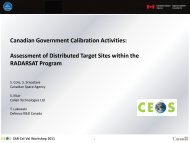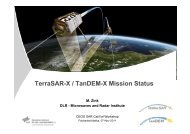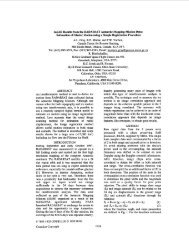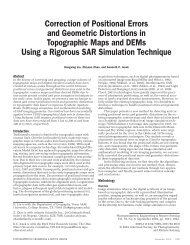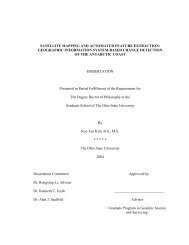Flow Variations of the Antarctic Ice Sheet from Comparison of ...
Flow Variations of the Antarctic Ice Sheet from Comparison of ...
Flow Variations of the Antarctic Ice Sheet from Comparison of ...
You also want an ePaper? Increase the reach of your titles
YUMPU automatically turns print PDFs into web optimized ePapers that Google loves.
<strong>Flow</strong> <strong>Variations</strong> <strong>of</strong> <strong>the</strong> <strong>Antarctic</strong> <strong>Ice</strong> <strong>Sheet</strong> <strong>from</strong> <strong>Comparison</strong> <strong>of</strong> Modern and Historical Satellite<br />
Data<br />
Kenneth C. Jezek<br />
Byrd Polar Research Center<br />
The Ohio State University<br />
1090 Carmack Road<br />
Columbus, OH 432 10<br />
oezek@iceberg.mps.ohio-state.edu)<br />
INTRODUCTION<br />
Since 1962, high quality satellite images <strong>of</strong> <strong>the</strong> <strong>Antarctic</strong><br />
have been acquired which cover much <strong>of</strong> <strong>the</strong> Sou<strong>the</strong>m<br />
Continent. The earliest images, <strong>from</strong> <strong>the</strong> Corona Program,<br />
have only recently become available to <strong>the</strong> science<br />
community [l]. They reveal a rich variety <strong>of</strong> details about<br />
<strong>the</strong> ice sheet, ice shelves, grounding lines, and rocky areas<br />
[2,3,4]. The most recent high-resolution images covering all<br />
<strong>of</strong> <strong>Antarctic</strong>a were collected by <strong>the</strong> Canadian Radarsat-1 in<br />
September and October <strong>of</strong> 1997 [5,6]. That activity, a<br />
collaboration between NASA and <strong>the</strong> Canadian Space<br />
Agency, has resulted in <strong>the</strong> first, complete, high resolution<br />
SAR mapping <strong>of</strong> <strong>the</strong> <strong>Antarctic</strong>. The Radarsat images are also<br />
spectacular and graphically portray <strong>Antarctic</strong> ice streams,<br />
outlet glaciers, calving margins, and mountains.<br />
This paper examines how different <strong>Antarctic</strong> flow regimes<br />
have changed over <strong>the</strong> 35-year interval between Corona and<br />
Radarsat. Study areas focus on <strong>the</strong> Ross <strong>Ice</strong> Shelf and Crary<br />
<strong>Ice</strong> Rise. The comparison reveals dramatic variations in ice<br />
flow, particularly around Crary <strong>Ice</strong> Rise - an area <strong>of</strong> long<br />
standing glaciological interest because <strong>of</strong> its potential for<br />
retarding upstream flow (fig. 1).<br />
a<br />
1<br />
C<br />
Fig. 1. Crary <strong>Ice</strong> Rise imaged by three spaceborne sensors: a) Optical Corona satellite imagery <strong>from</strong><br />
1963 (DISP); b) SPOT optical imagery <strong>from</strong> 1995; c) Radarsat syn<strong>the</strong>tic aperture radar microwave<br />
imagery <strong>from</strong> 1997. North is approximately up. In each image, <strong>the</strong> ice rise is about 24 km wide at its<br />
mid-point.<br />
0-7803-4403-0/98/$10.00 0 1998 IEEE 2240
ANALYSIS<br />
Crary <strong>Ice</strong> Rise (83S, 174W) is situated in <strong>the</strong> sou<strong>the</strong>astern<br />
corner <strong>of</strong> <strong>the</strong> Ross <strong>Ice</strong> Shelf, <strong>Antarctic</strong>a. Surrounded by -<br />
400 m thick ice floating on <strong>the</strong> Ross Sea, Crary <strong>Ice</strong> Rise is an<br />
ice capped island that rises nearly 50 m above <strong>the</strong> adjacent<br />
shelf ice. The rise rests in <strong>the</strong> downstream ice flow <strong>from</strong> two<br />
West <strong>Antarctic</strong> <strong>Ice</strong> Streams. As such, some investigators<br />
conjecture that <strong>the</strong> ice rise presents an obstruction to ice flow,<br />
effectively damming <strong>the</strong> upstream ice and contributing to <strong>the</strong><br />
stability <strong>of</strong> <strong>the</strong> inland ice sheet.<br />
More recent studies <strong>of</strong> <strong>the</strong> ice rise suggest that Crary <strong>Ice</strong><br />
Rise is changing - and consequently <strong>the</strong> effect <strong>the</strong> ice rise has<br />
on local ice flow [7]. Based on ice thickness and ice surface<br />
velocity data, <strong>the</strong> shelf immediately downstream <strong>of</strong> <strong>the</strong> ice<br />
rise is estimated to be thinning by about 1 m/y. Southwest <strong>of</strong><br />
<strong>the</strong> ice stream, <strong>the</strong> ice shelf is believed to be thickening by a<br />
similar amount. These calculations lead to speculation that<br />
<strong>the</strong> location <strong>of</strong> <strong>the</strong> ice rise may be shifting. Photographs<br />
taken by <strong>the</strong> Corona Satellite in 1963 and <strong>the</strong>n, 32 years later,<br />
by <strong>the</strong> SPOT Satellite, and most recently by Radarsat-1,<br />
support this idea (fig 1).<br />
Declassified Intelligence Satellite Program (DISP) data<br />
were obtained in <strong>the</strong> form <strong>of</strong> a 4 by 5-inch positive<br />
transparency. The film product was digitized at 7-micron<br />
resolution that is commensurate with <strong>the</strong> 150-m spatial<br />
resolution <strong>of</strong> <strong>the</strong> original product. Both <strong>the</strong> DISP and<br />
Radarsat-1 data were warped to <strong>the</strong> geolocated SPOT image<br />
using a first degree polynomial and tie points selected at<br />
locations judged to be stable.<br />
There are numbers <strong>of</strong> striking differences between <strong>the</strong><br />
images. The most obvious differences are <strong>the</strong> seemingly<br />
fresh, sinusoidal cracks present in 1963 along <strong>the</strong><br />
nor<strong>the</strong>astern ‘hook’ <strong>of</strong> <strong>the</strong> ice rise. By 1995 <strong>the</strong> cracks have<br />
evolved into segmented blocks that are being rotated by <strong>the</strong><br />
shearing flow past <strong>the</strong> ice rise.<br />
There are also more subtle variations in flow over time and<br />
variability <strong>from</strong> location to location around <strong>the</strong> ice rise. The<br />
DISP image suggests a number <strong>of</strong> small ice rumples south<br />
southwest <strong>of</strong> <strong>the</strong> main ice rise (location a in fig. 2). The<br />
region downstream <strong>of</strong> <strong>the</strong> ice rumples seems to be largely<br />
crevasse free. By <strong>the</strong> mid 1990s, crevasses are clearly<br />
evident and surround several <strong>of</strong> <strong>the</strong> rumpled areas. Crevasses<br />
on <strong>the</strong> eastern flank <strong>of</strong> <strong>the</strong> sou<strong>the</strong>rn part <strong>of</strong> <strong>the</strong> ice rise are<br />
nearly unchanged over <strong>the</strong> same period (b fig. 2). The<br />
interior <strong>of</strong> <strong>the</strong> ice rise nor<strong>the</strong>rn embayment, or ‘hook’, seems<br />
relatively undeformed in <strong>the</strong> 1963 image. The radar image<br />
suggests it is cut by long arcuate crevasses formed in<br />
response to <strong>the</strong> shearing flow past <strong>the</strong> embayment. However,<br />
<strong>the</strong> appearance <strong>of</strong> <strong>the</strong> crevasses in <strong>the</strong> SAR imagery may well<br />
be a consequence <strong>of</strong> <strong>the</strong> penetration <strong>of</strong> microwave energy<br />
into snow bridges - revealing crevasses undetectable in ei<strong>the</strong>r<br />
<strong>the</strong> DISP or SPOT data.<br />
Remarkably, a number <strong>of</strong> objects east <strong>of</strong> <strong>the</strong> ice rise are<br />
Fig 2. 1963 DISP image portion (120 km across). Solid lines are lineaments based on<br />
1995 SPOT image. Dashed lines are lineaments based on 1997 Radarsat image<br />
224 I
evident between <strong>the</strong> imagery. These reveal a<br />
counterclockwise rotational component to ice flow that<br />
becomes more pronounced to <strong>the</strong> north. Speeds <strong>of</strong>f <strong>the</strong><br />
sou<strong>the</strong>rn flank <strong>of</strong> <strong>the</strong> ice rise are about 130 m per year (c).<br />
Near <strong>the</strong> righl hand portion <strong>of</strong> <strong>the</strong> hook speeds drop to about<br />
35-m per year (d) and <strong>the</strong>re is little evidence for motion with<br />
<strong>the</strong> embayment itself. Speeds are about 350 m per year 10<br />
km downstream <strong>of</strong> <strong>the</strong> nor<strong>the</strong>rn nose <strong>of</strong> <strong>the</strong> ice stream.<br />
Speeds increase 25 % after about 25 km <strong>of</strong> downstream flow<br />
based on <strong>the</strong> position <strong>of</strong> <strong>the</strong> large riRs that form episodically<br />
at <strong>the</strong> nor<strong>the</strong>m tip <strong>of</strong> <strong>the</strong> ice stream.<br />
Finally, <strong>the</strong> grounding line on <strong>the</strong> southwestern flank <strong>of</strong> <strong>the</strong><br />
ice rise has advanced outward and upglacier by about 1500 m<br />
between 1963 and 1997. This is consistent with ice<br />
thickening along this flank <strong>of</strong> <strong>the</strong> ice rise and with little ice<br />
thickness change along <strong>the</strong> sou<strong>the</strong>astem flank. <strong>Ice</strong> thickening<br />
may also explain <strong>the</strong> onset <strong>of</strong> extensive crevassing along <strong>the</strong><br />
southwestem flank. There will be more extensive coupling<br />
between <strong>the</strong> ice and <strong>the</strong> bed as <strong>the</strong> ice thickens in <strong>the</strong> ice<br />
rumple region. The coupling will lead to increased basal<br />
shear stresses which will be manifest as surface crevasses.<br />
SUMMARY<br />
Large portions <strong>of</strong> this sector <strong>of</strong> <strong>Antarctic</strong>a are susceptible<br />
to dramatic changes in ice flow. <strong>Ice</strong> streams, large rivers <strong>of</strong><br />
ice that drain <strong>the</strong> West <strong>Antarctic</strong> <strong>Ice</strong> <strong>Sheet</strong> into <strong>the</strong> Ross <strong>Ice</strong><br />
Shelf, are known to turn ‘on and <strong>of</strong>f on time periods <strong>of</strong> many<br />
100’s <strong>of</strong> years. This in turn leads to local changes in <strong>the</strong><br />
grounding line, <strong>the</strong> location where <strong>the</strong> terrestrial ice sheet<br />
goes ailoat. It is believed that rapid changes in ice sheet<br />
behavior are in fact due to changes in <strong>the</strong> internal dynamics<br />
<strong>of</strong> <strong>the</strong> ice sheet. Ra<strong>the</strong>r than extemal climate forces, changes<br />
in glacier physical properties, such as subglacial water flow<br />
patterns, are presumed to be <strong>the</strong> important feedback<br />
mechanisms controlling rapid changes in <strong>the</strong> ice sheet. The<br />
structure <strong>of</strong> Crary <strong>Ice</strong> Rise eventually responds to inland ice<br />
sheet changes by growing or retreating as <strong>the</strong> upstream ice<br />
flux shifts.<br />
The present pattem <strong>of</strong> thinning along <strong>the</strong> nor<strong>the</strong>astern<br />
margin <strong>of</strong> <strong>the</strong> ice shelf and thickening along <strong>the</strong> southwestem<br />
margin may have been repeated in <strong>the</strong> past [SI. Evidence for<br />
this comes <strong>from</strong> ice thickness patterns far downstream <strong>of</strong> <strong>the</strong><br />
ice rise. Here, <strong>the</strong> ice shelf acts as a ‘tape-recorder’<br />
preserving remnants <strong>of</strong> ice thickness pattems <strong>of</strong> an earlier<br />
time. Paired ice thickness hollows and domes similar to <strong>the</strong><br />
pattem seen today are located about 200 km downstream <strong>of</strong><br />
<strong>the</strong> ice rise. Using present day ice velocities, <strong>the</strong>se<br />
observations suggest a similar process occurred around <strong>the</strong><br />
ice rise some 400 years ago. The Corona and SPOT data<br />
suggest researchers may now have an opportunity to study a<br />
repeat <strong>of</strong> that same, and perhaps episodic, process.<br />
ACKNOWLEDGMENTS<br />
This work was supported by NASA and under a<br />
cooperative agreement with <strong>the</strong> Canadian Space Agency. G.<br />
Hamilton contributed to <strong>the</strong> data analysis.<br />
REFERENCES<br />
[l] Macdonald, R.A, 1995. Corona: Success for space<br />
reconnaissance. A look into <strong>the</strong> cold war and a<br />
revolution in intelligence. Photogramm. Eng. Remote<br />
Sens., LXI, p 321-325.<br />
[2] Committee on Environmental and Natural Resources<br />
Research, 1997. Our Changing Planet: The FY 1997<br />
U.S. Global Change Research Program.<br />
[3] Bindschadler, R. and P. Vomberger, 1998. Changes in<br />
<strong>the</strong> West <strong>Antarctic</strong> <strong>Ice</strong> <strong>Sheet</strong> since 1963 <strong>from</strong><br />
Declassified Satellite Photography. Science, vol. 279,<br />
p. 689-692.<br />
[4] Paulsen, T. and T. Wilson, 1998. Declassified<br />
Intelligence Satellite Photographs (DISP) provide first<br />
high-resolution space-bome views <strong>of</strong> <strong>the</strong> Transantarctic<br />
Mountains in <strong>the</strong> <strong>Antarctic</strong> interior. EOS, vol. 79, no. 8,<br />
[5] Jezek, K.C., H.G. Sohn, and K.F. Noltimier, in press.<br />
The Radarsat <strong>Antarctic</strong> Mapping Project. Proceedings<br />
IGARSS’98, Seattle, WA.<br />
[6] Jezek, K.C. and 11 o<strong>the</strong>rs, in press. Snapshots <strong>of</strong><br />
<strong>Antarctic</strong>a <strong>from</strong> Radarsat-1 . Proceedings IGARSS’98,<br />
Seattle, WA.<br />
[7] Bindschadler, R., 1993. Siple Coast Project research <strong>of</strong><br />
Crary <strong>Ice</strong> Rise and <strong>the</strong> mouths <strong>of</strong> <strong>Ice</strong> Streams Band C,<br />
West <strong>Antarctic</strong>a: review and new perspectives. J. <strong>of</strong><br />
Glac., vol. 39, no. 133, p. 538-552.<br />
[SI<br />
Jezek, K.C., 1984. Recent changes in <strong>the</strong> dynamical<br />
condition <strong>of</strong> <strong>the</strong> Ross <strong>Ice</strong> Shelf, <strong>Antarctic</strong>a. J. Geophys.<br />
Res., vol. 89, no. B 1, p. 409-4 16.<br />
2242



